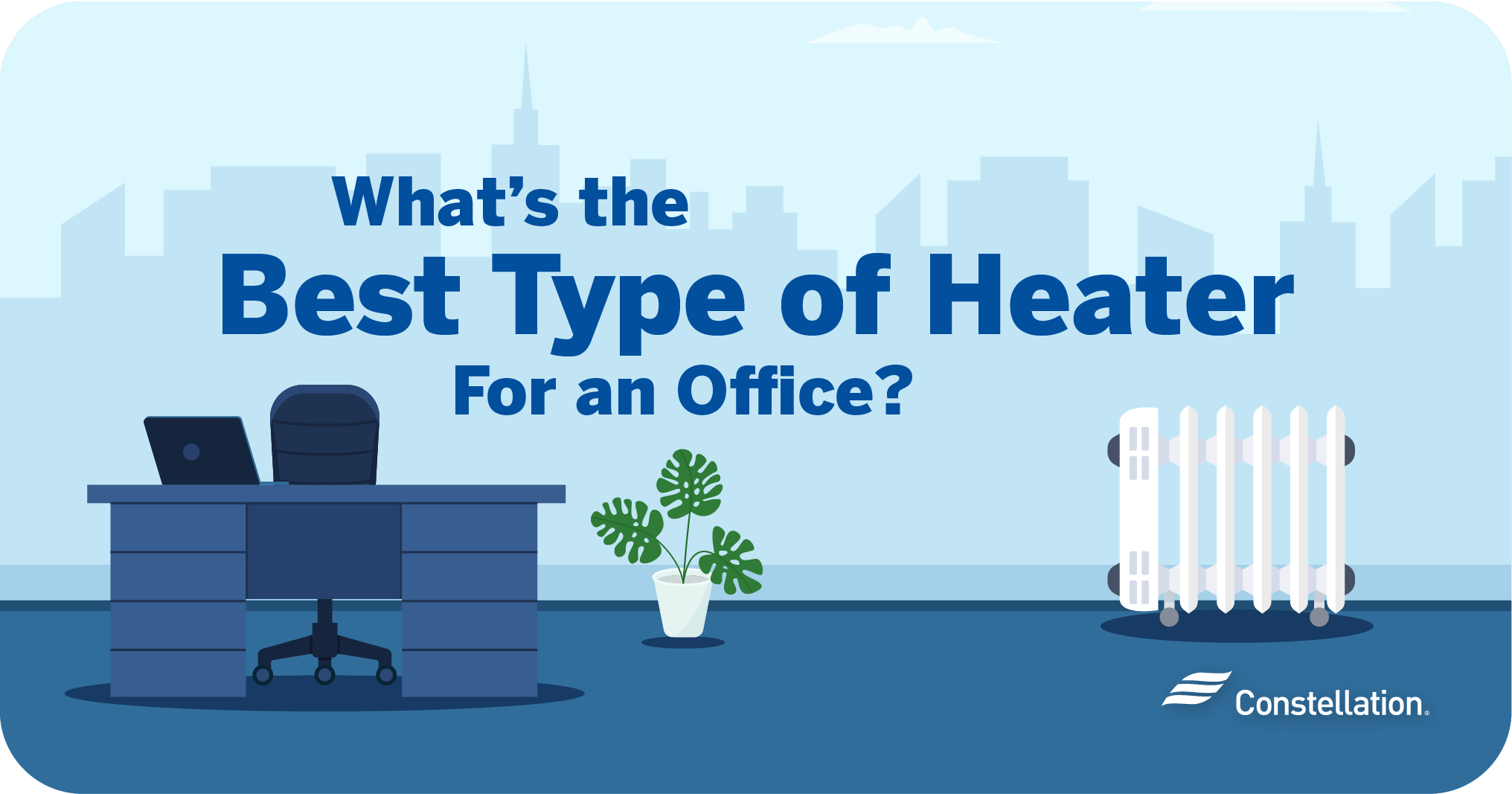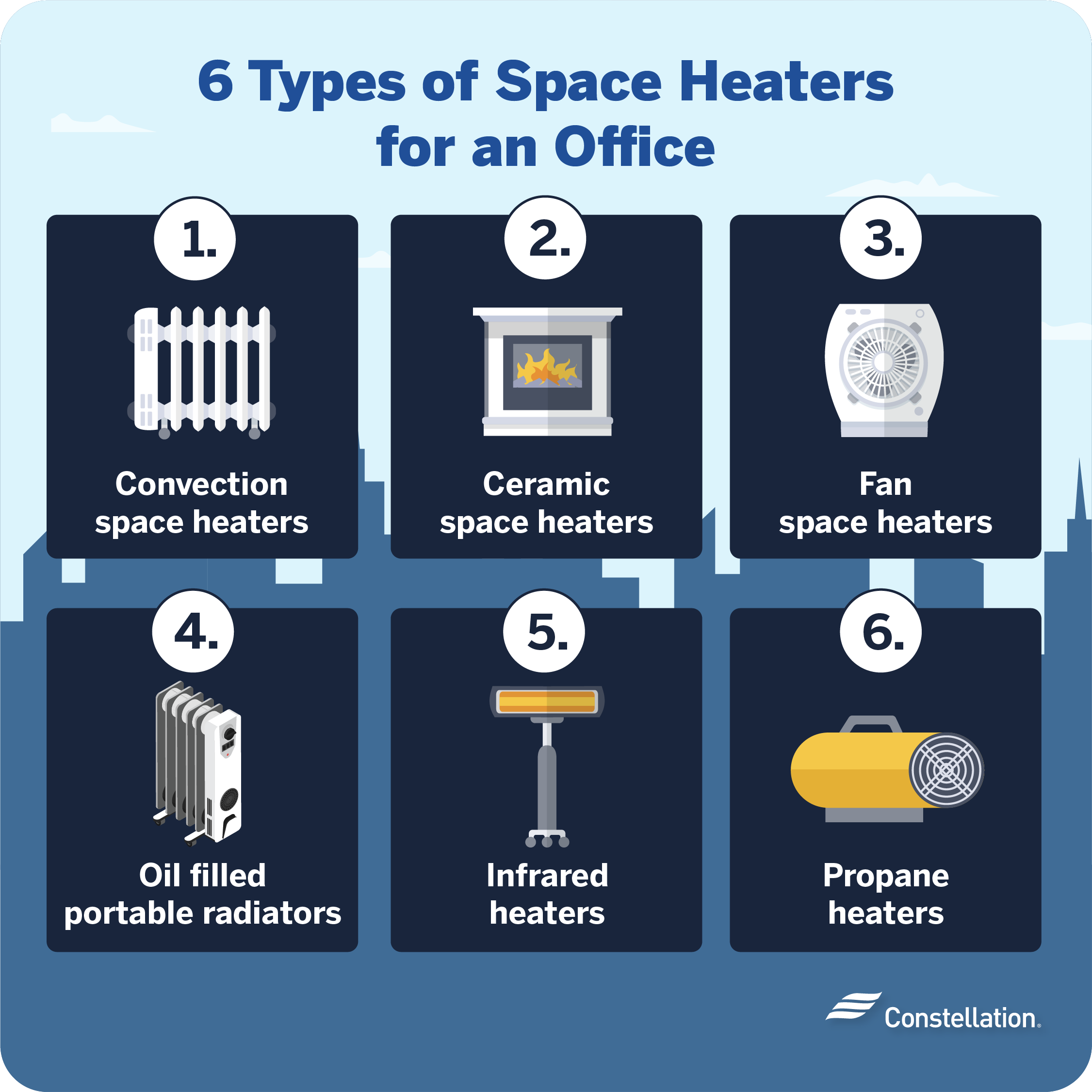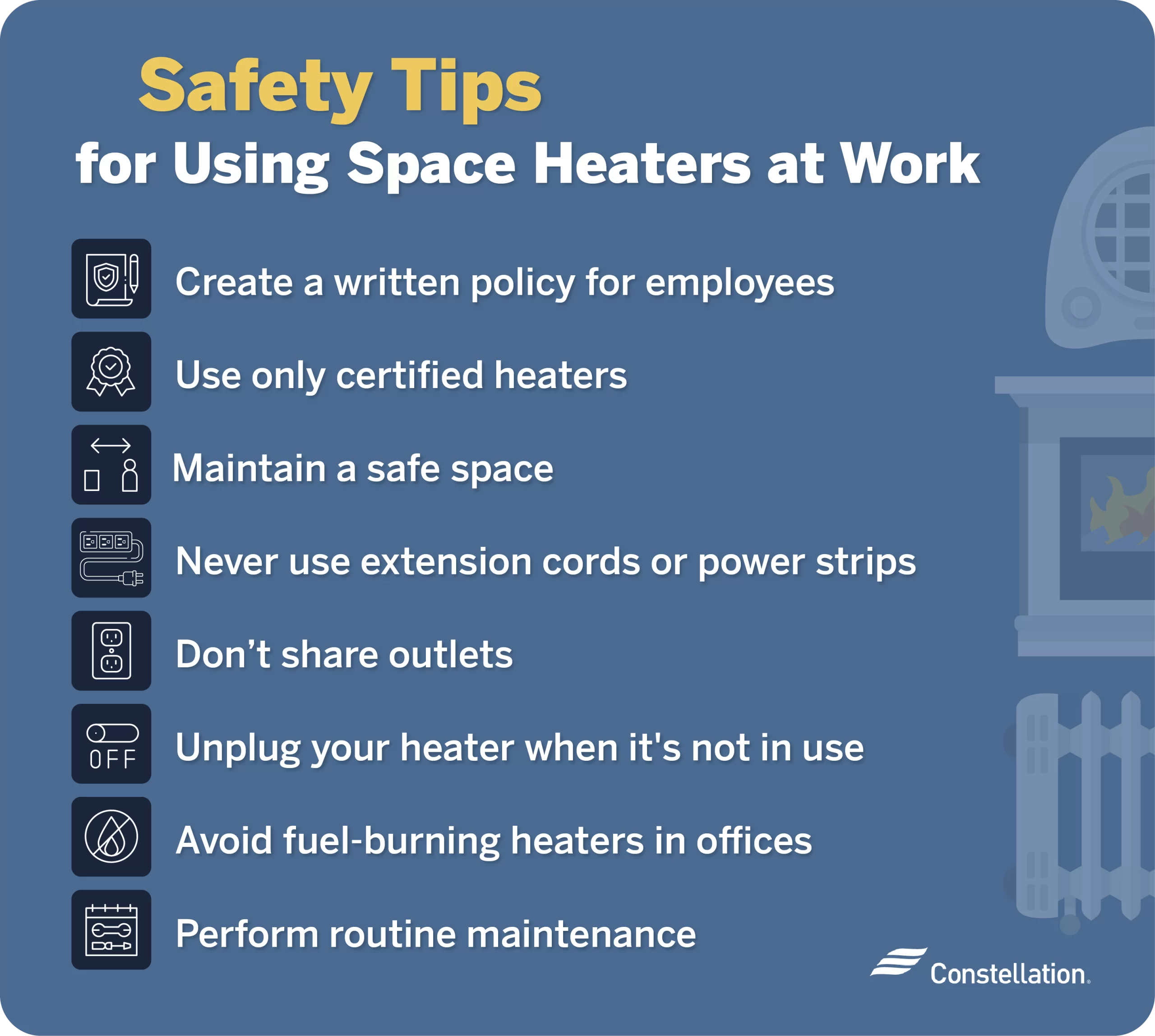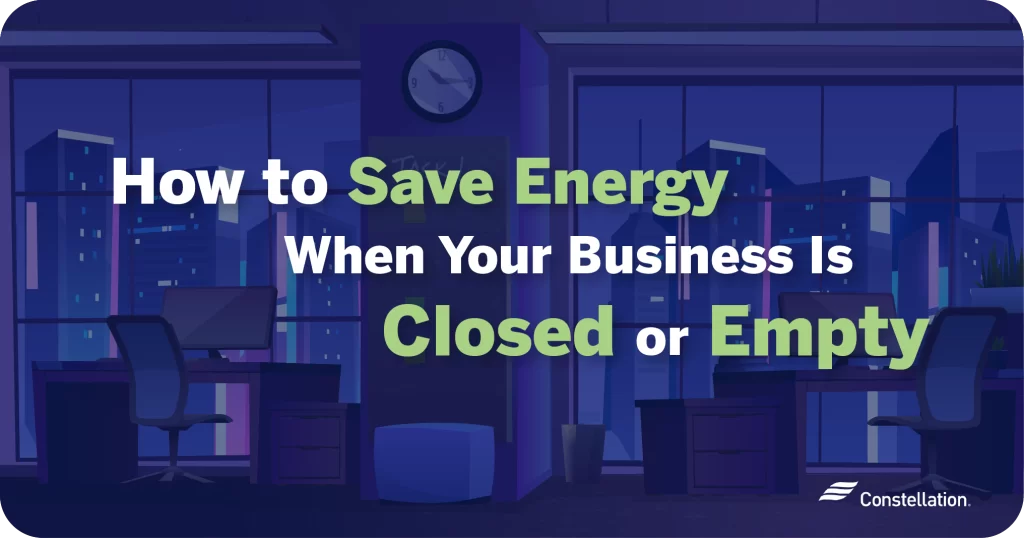
- Category:
Small Business Energy Savings -
Last updated:
October 23, 2025
What’s the Best Type of Space Heater for an Office?
Keeping employees warm and comfortable supports quality work, productivity and well-being. Yet, that simple goal isn’t always easy to achieve. Temperatures can vary tremendously in different areas of your office. While various studies have found the ideal office temperature range to be between 73 to 77 degrees, people often disagree as to what the best temperature actually is.
You have office heater options for maintaining the ideal temperature overall and accommodating the needs of individuals in your company. You will need to balance cost with practicality and energy efficiency. In many cases, office space heaters can minimize small business utility costs.
Jump to a section:
- How to choose the right office space heater
- 6 types of space heaters
- Safety tips for using space heaters at work
- How much energy do space heaters use?
- Office space heater FAQs
- Determining the best type of heater for your office
How to choose the right office space heater
A space heater is a popular and effective solution for a cold office. With so many types of space heaters available, choosing the right one requires balancing warmth, efficiency and workplace safety.
Here are some of the factors to consider for your place of business:
- Office size and heating needs: A small heater might work for a single desk, but it will likely struggle to heat a larger space. Right-sizing your space heater will improve comfort and efficiency.
- Heating method: You can choose convection heaters that warm the air in a room, radiant heaters that directly warm people and objects or fan-forced models that circulate heated air.
- Energy efficiency and cost: Models with adjustable thermostats, timers and energy-saving operating modes can lower your energy usage without sacrificing comfort.
- Safety features: Protect workers and property with models that shut off if the unit tips. These automatic shut-off features can prevent fires. And units that stay cool to the touch lower the risk of burns.
- Noise level: Fan-forced heaters can be distractingly loud. Radiant and convection units are much quieter and are a good option for offices.
- Placement and portability: Being able to move units where they’re needed can accommodate changing conditions throughout the day.
- Convenient controls: Digital and programmable units make it easier to maintain a consistent temperature during the day. A remote control adds convenience.
- Design considerations: How a unit looks, how well it blends into your decor and whether it can be attached to a wall or rolled on the floor are all factors to consider.
6 types of space heaters for an office

You will find a variety of office space heater technologies and types on the market. Here are the most popular types, along with an explanation of their strengths and weaknesses. You can use this information to determine the best heater for office use in your facility.
1. Convection space heaters
Office space heaters use convection technology to circulate warm air in a space. An electric heating element creates warm air, which then rises within the unit and exits the top. The movement of the warm air up draws in cool through bottom vents.
Pros and cons of convection space heaters
Convection heaters have a number of advantages.
- Operate silently without fans
- Maintain an even temperature through the space
- Energy efficiency
- Versatile in various work settings
When thinking about the best heater for office spaces, be aware of some of the drawbacks.
- Difficult to feel warmth unless you are nearby
- Require more time to heat up a space
- May stir up dust
2. Ceramic space heaters
This kind of office space heater packs a lot of power into a small package. They create heat by passing electricity through coils surrounded by ceramic plates that heat up fast and radiate heat into the surrounding space. Some have a fan mode that aids the diffusion of heat.
Pros and cons of ceramic space heaters
The advantages of a ceramic office heater include:
- Small size
- Lightweight and portable
- Works fast to heat your space
- Inexpensive
Some of the disadvantages include:
- Heats only a small area
- Has to run constantly to provide heat
3. Fan space heaters
Models using this technology are simple: electricity heats a metal coil, then a fan blows hot air into your space. For quickly warming up a room, these types of space heaters are hard to beat. On the downside, they tend to be noisy and dry out the air.
Pros and cons of fan space heaters
Fan space heaters are a popular office heater choice for these reasons:
- Long lasting
- Inexpensive
- Work immediately
- Compact and lightweight
Fan space heaters do have some faults:
- Can be noisy
- Possible fire hazard
- Has to run and use energy constantly
- Will not warm a large space
- Can create dry skin
4. Oil-filled portable radiators
These devices are constructed with metal tubes filled with oil in designs that look like the steam or water radiators in old houses. Electrical energy heats the oil in the tubes, and like old radiators, they warm your space by radiating heat.
Pros and cons of oil-filled space heaters
Oil-filled space heaters are popular because of their:
- Quiet operation
- Clean, dustless heat
- Long lasting heat after being turned off
Oil space heaters do have some faults.
- Take a while to heat up
- Are very hot to the touch
- Flammable oil can catch fire
- May leak oil if tipped over
5. Infrared heaters
The way these heaters work is fundamentally different from those above. Instead of some device heating the air, these units emit electromagnetic waves that heat up objects like the sun shining down on the earth.
Pros and cons of infrared space heaters
Infrared space heaters offer advantages:
- Quiet operation
- Long lasting heat
- Cozy feeling
Infrared space heaters are not for everyone.
- Are more expensive
- Emit heat in only one direction
- Can be heavy and less portable
- Don’t work well in empty rooms
6. Propane heaters
Instead of using electricity, these portable heaters burn propane to create heat. They can warm a large area quickly, but should only be used in well-ventilated spaces due to the risk of carbon monoxide poisoning and water vapor buildup.
Pros and cons of propane space heaters
People like propane space heaters because they are:
- Ultra portable and don’t need electricity
- Able to heat a room fast
- Less costly to operate
- Inexpensive to buy
Consider the downsides of propane space heaters carefully:
- Higher risk of fire or even an explosion
- Temperature control is difficult–they are hot or not
- Emit carbon dioxide
- Also emit water vapor, creating a clammy feeling
Safety tips for using space heaters at work

While office space heaters can enhance comfort and productivity, they require an understanding of their risks and proper operation. The Electrical Safety Foundation International (ESFI) and various state and local organizations suggest the following safety tips when operating a heater in your office:
- Create a written policy and require company approval. You don’t want employees to bring all manner of heaters to the workplace. Ensure you know which units are operating where and that employees have a clear policy to follow.
- Use only certified heaters. Only allow heaters that have been tested by an independent laboratory, like Underwriters Laboratories, so you know they comply with basic safety standards.
- Maintain a safe space. Most heaters require at least three feet of distance between them and materials that can catch fire. Paper, clothing, rugs and curtains that are too close to the heater are the top cause of office fires. Also, be sure they’re not blocking doors or hallways.
- Never use extension cords or power strips. Plug the unit directly into the wall outlet to prevent tripping and overheating.
- Don’t share outlets. Avoid plugging anything else into the outlet that you’re using for the space heater.
- Turn off and unplug your heater when it’s not in use. Leaving a unit on with no one around is a waste of energy and can also increase the risk of fire.
- Avoid fuel-burning heaters in offices. Propane, butane and kerosene heaters emit dangerous fumes and sometimes moisture. Only use them in open, well-ventilated spaces.
- Perform routine maintenance. Check cords for damaged insulation and discard units with bent plugs. Make sure the unit is free from damage and that it operates properly before using it.
How much energy do space heaters use?
Space heaters vary in how energy-efficient they are. When determining how much energy space heaters use, consider your specific model’s wattage, efficiency features, how long you run it and how it’s being used.
For example, if you’re warming chilly areas for a few hours a day, a space heater can be an energy-efficient boost that helps lower the load on your HVAC system.
Here’s a more detailed look at calculating how much energy your office space heater might use:
The cost of heating an office with a space heater
How much energy your space heater uses and the cost to run it depend on its wattage, how many hours you use it and the cost of electricity in your area.
Most portable heaters are designed to use 1,500 watts per hour when on high. The current national average price per kilowatt-hour is $0.1388. Here’s how to estimate your operating cost:
(Wattage per hour of use × number of hours used) ÷ 1,000 = kWh
kWh × cost of electricity = Estimated cost per day
For example, if you run a heater with an average 1,500-watt per hour rating for eight hours, at $0.1388 per kWh, your calculation will look like this:
(1,500 × 8) ÷ 1,000 = 12 kWh
12 kWh × $0.1388 = $1.67 per day
Determining how much office heating costs is an important step in making choices about the best heater for office spaces.
Upgrading your building’s system to serve colder areas is expensive. It may be more cost-effective to fine-tune the temperatures in your facility by adding office space heaters. Learning how to lower your utility costs helps your business be more profitable in all seasons.
Office space heater FAQs
What size heater do I need for a small office?
The average 1,000- to 1,500-watt heater is effective for warming an area of up to 150 square feet, which is the typical size of a small office or individual work space. Other factors to consider when sizing your heater are:
- The quality of insulation in your space
- The number of windows in it
- Whether or not the space is drafty
Which type of space heater is most energy-efficient?
If you need spot heating, a radiant heater is the most efficient choice. If you want to maintain a comfortable temperature all day, an oil-filled or convection model may be better.
You can boost the energy efficiency of your unit with programmable controls that prevent overheating. Some units also have an eco-mode or energy-saving setting that can help reduce energy usage.
What safety features should I look for in a space heater?
The best portable heater for an office or other business space is one that’s high-quality, safe and efficient. This includes units that meet the standards of an independent testing lab.
Safety features to look for are:
- Automatic shut-off if the unit tips over to help prevent fire
- Protection that shuts it off when it reaches an unsafe temperature
- Cool-touch exterior surfaces to prevent the risk of burns
Safety is also a matter of placement and usage:
- Keep the unit at least three feet from anything flammable.
- Ensure it’s on a flat, stable surface.
- Plug it directly into a wall outlet.
- Don’t plug any other devices into that outlet.
- Never leave a unit running unattended.
Determining the best type of heater for your office
The best space heater for office use depends on the specifics of your situation. Consider the size of your space, its heating needs, how long the unit will run and how often it will be on.
Take time to compare the types of space heaters available, including:
- The energy efficiency of each one
- How noisy it is
- Its convenience and safety features
Look beyond the purchase price to consider the cost to operate the unit. Making the right choice can help reduce HVAC energy use, as well as reduce waste. Using heaters strategically in an office space can significantly reduce your small-business energy consumption.
We invite you to explore our small business blog for more practical ideas on lowering your business expenses and improving your energy efficiency.




